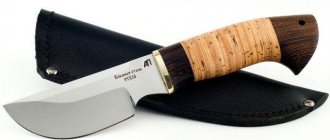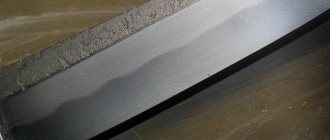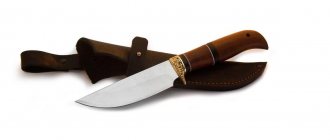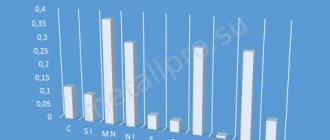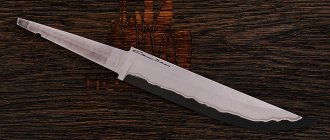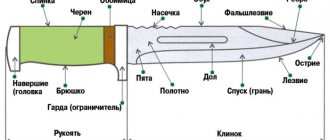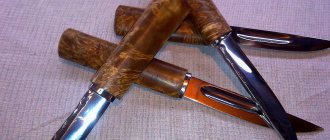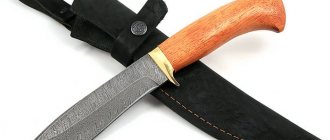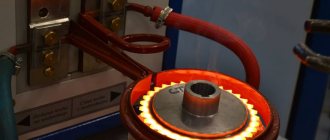Modern technologies make it possible to create unique knife blades that have high-quality properties and can be used in various conditions. For example, today powder steel has become very popular as an excellent material for making knives. Experts say that today powder steels have the best quality among other materials. The market presents knives made of this material of exceptionally high and medium quality.
Types of powder alloys for making knives
In the manufacture of different types of knives, a variety of powder steel is used in four classes: premium, high-end, middle and low class . Depending on the quality of the steel, the material is used in various types of structures. Let's look at the two highest classes of powder material in more detail - premium and high-end alloys.
Premium class
CPM S30V – has increased wear resistance and has excellent blade sharpening capabilities. This steel is an American alloy that is used exclusively in expensive premium knives, mainly for the production of hunting knives, as it is considered a hard and durable powder alloy.
M390 is a modern stainless alloy with unique anti-corrosion and wear-resistant properties, including chromium and vanadium. This steel is easy to sharpen and does not dull for a long time. Many experts believe that the M390 alloy is the best today for the production of high-quality knives.
CPM S35VN is an upgraded S30V alloy with the addition of niobium and an improved fine powder . This type of steel sharpens well and has increased strength.
Elmax is a popular European-made containing molybdenum, vanadium, and chromium. This allows you to create easily sharpened blades with high anti-corrosion properties .
ZDP-189 is an innovative alloy from Japan , which has high hardness and relatively high ductility. Blades made of this steel cut well and are easy to polish.
High end
154CM is an American carbide alloy that has excellent qualities, such as good blade sharpening and anti-corrosion properties. This type of steel is similar to CPM S35VN but is not as high quality.
ATS-34 is the Japanese equivalent of the 154CM. This alloy is very popular in the production of bladed weapons for professionals . It is ideal for sharpening and is resistant to rust and other types of corrosion.
D-2 – this type of steel can rust because it contains a very small amount of chromium. At the same time, blades made from this alloy are wear-resistant, and most importantly, harder than their analogues - 154CM and ATS-34.
VG-10 is a high-quality analogue of all the above alloys, which additionally uses vanadium and chromium, which improves its performance properties. VG-10 steel is used in Japan to produce frequently sharpened blades . The material is considered hard, but not strong enough for use in hunting knives.
Advantages and disadvantages
Steel 95X18 has characteristics that are valued by knife manufacturers. These include:
- High strength. Strict adherence to temperature at the quenching and tempering stage ensures high strength of steel. A knife made of such an alloy can withstand severe external loads.
- Hardness. On average, it is 58 - 60 units on the Rockwell scale, and the maximum value can reach 62 HRC. A knife made of this steel grade is able to withstand heavy loads without deforming.
- Increased wear resistance. Even with frequent use, the knife does not lose its sharpness for a long time.
- Resistant to corrosion and aggressive environments. The alloy is not afraid of water, acid, or salts. Even with prolonged contact with them, rust does not appear on the blade and its attractive appearance is not lost.
- Easy to sharpen. No special tools are required to restore the blade to its former sharpness. A regular sharpening stone will do. It is recommended to use a diamond-coated stone with fine grit.
- Low price. In terms of cost, knives made from steel 95X18 are cheaper than their foreign counterparts, and in quality they are in no way inferior to them. This cannot but attract buyers.
- Attractive appearance. A blade made of this steel grade has a bright metallic luster that does not fade even when interacting with acids and salts.
There are few disadvantages to knives made of steel 95X18:
- Under heavy breaking loads, the blade may break. Also, knives made of this steel do not withstand shock loads well.
- Steel is demanding to maintain a certain temperature during processing. When overheated, it becomes brittle.
Manufacturers often use 95X18 to make knives. The intricacy of the alloy in manufacturing is compensated by the high quality and numerous advantages of this grade of steel.
Process of making a powder steel knife
Modern powder alloys for the manufacture of blades contain a sufficient degree of carbides and non-metallic inclusions , and the grain structure according to the phase transition is as follows: martensite, austenite .
Carbides of various types are hard and at the same time brittle materials that increase the wear resistance of the alloy, but at the same time worsen its mechanical characteristics , for example, the overall strength and toughness of the steel. If this element is distributed unevenly, then anisotropy of various characteristics of the blade may occur, the overall appearance of the knife becomes heterogeneous and its structure becomes unpredictable.
To prevent this from happening, the following technologies are used in powder metallurgy:
- Alloy optimization – industrial reduction of the amount of eutectic types of carbides;
- Microalloying is the addition of strong carbide formers or rare earth elements and the second group to the alloy during steel production;
- Plastic deformation - by crushing carbides, their distribution in composition is improved;
- Increasing the quality and rate of crystallization of powder steel.
Once the powder alloy composition is ready for the production of a blade blank, the production of the knife itself begins. This process occurs in several stages:
- The alloy is atomized , resulting in a metal powder, each particle of which is a microscopic ingot;
- Powdered metal is processed if necessary;
- After this, the metal powder is poured into a vacuum mold made of plastic materials;
- is pressed under high pressure;
- Next, solid-phase and two-phase sintering under high temperature and pressure of several hundred atmospheres.
Thus, the production of the knife is completed. Next, the manufacturing company creates the handle and decorates the blade in accordance with the requested requirements.
All the pros and cons of powder steels
We looked at what lies behind such an unusual name “powder steel” in the first part of this article, but now it’s worth summing up and trying to briefly write down all the positive and negative aspects of powder steels.
The advantages of powder steels include:
- Flexibility . Indeed, due to its small size and distribution of carbides as close to ideal as possible, in this type of steel it is possible to significantly increase the degree of alloying, which will lead to an increase in its resistance properties.
- Mechanics . For the same reasons, with a reasonable approach to limiting the amount of carbide phase, a noticeable improvement in mechanical properties can be achieved.
- Grinding . Due to the fact that powder steel contains small, evenly distributed carbides, they are much more amenable to grinding and forging.
- Hardening . During the hardening process, powder steel receives a more saturated solid solution, finer and more uniform grain. As a result, there is an increase in its hardness, heat resistance, mechanical properties and corrosion resistance.
- Manufacturing . Powder technology makes it quite easy to produce high-nitrogen steels using solid-phase nitriding methods.
- Application . Powder steels can easily be used to create materials using mechanical alloying methods (carbide steels, cermets, DUO steels).
With a rather impressive list of advantages, like everything in this world, powder steel also has some disadvantages:
- Powder processing expands, but does not eliminate alloying limits. For example, if such steel does not have eutectic carbides in its structure, then its powder processing does not make sense and most often leads to some deterioration in properties.
- Powder processing steels contain a larger amount of non-metallic inclusions, however, recently, thanks to the efforts of scientists, this factor has already been successfully combated.
- Powder grade steel is noticeably more expensive. In addition, their successful production requires expensive special equipment, and there are also restrictions on the maximum size of workpieces.
It is necessary to understand that powder processing is not a magic wand. It solves one problem - combating carbide heterogeneity. It is most appropriate to produce high-alloy steels (for example, high-speed or corrosion-resistant) by this method, where the improvement in durability, mechanical and technological properties compensates for the increase in cost.
Today, the blades of almost 90% of knife products of various brands are made of powder steel.
Features of sharpening powder steel knives
The main difficulty after purchasing a powder alloy knife is sharpening it. Of course, this can be done, but often only in specialized workshops, because the blade of such a knife is quite hard and is sintered from separate structures, so improper distribution of forces on the knife blade during sharpening causes chipping of the knife blade on a larger scale than with similar steel knives, produced by stamping or forging.
In this regard, when sharpening a knife from powders at home, there is a danger of unevenness on its blade and microscopic chips as a result of choosing the wrong technology and sharpening devices.
Elmax powder steel is one of the most popular
Various alloys are used to make knives. Among the most popular is Elmax powder steel, which belongs to the premium class. It is used for the production of kitchen and cutting knives.
The best properties of Elmax
Powder steel knives have high technical characteristics. They are characterized by excellent cutting ability, wear resistance and good corrosion resistance. It makes excellent blades, durable, easy to use, and not afraid of blows.
They have high impact strength, which increases resistance to dynamic (impact) loads and destruction of the product. They are characterized by elasticity, which retains the properties of the material under mechanical stress. Hunting knives made of Elmax steel can be purchased in the KavkazSuvenir online store.
Convenience and ease of use
Powder alloys are considered very expensive, so they are most often used in the production of collectible knives. But this material is also used in the manufacture of edged weapons, including hunting and fishing knives . It is very rarely used to create kitchen knives, as it is very expensive. The most common uses of powder knives are in hunting, fishing, and military equipment .
But today, manufacturers also use low-quality powder steel, which costs several times less, which makes it possible to produce kitchen blades of very high quality. For example, Beta-ti Alloy and Blue Paper Super alloys are used for these purposes.
A knife made of this material is convenient to use, since its blade is so sharp that it easily cuts even paper . Modern sharpening technologies allow kitchen knives made from powders not to become dull for a long time and serve their owner as reliably as possible.
Advantages over other materials
Manufacturing technologies make it possible to create unique blades from powders that have various advantages over conventional knives. Here is a list of the main advantages of this unique material:
- It is possible to increase the quality distribution of carbides , which increases wear resistance, anti-corrosion and general mechanical characteristics of the material;
- Grinding is much easier than the same processing of ordinary steel;
- Powder steel production produces a high-tech nitrogen alloy that is harder than most analogues;
- The blades are much sharper than prototype knives made from other metals;
Disadvantages of the alloy
Of course, the main disadvantage of this type of alloy is the huge price of products made from powder . This is due to high-tech production and the complexity of sharpening the blade. But there are other disadvantages of this alloy, for example, the high content of foreign particles and non-metallic inclusions in steel of this type, which can get in during the forming phase of the product. Another disadvantage is the great difficulty and accuracy when sharpening at home, which leads to the fact that knives of this type must be used carefully. But these disadvantages are offset by the advantages of powder steel knives, especially their extraordinary sharpness and high wear resistance, and most importantly, anti-corrosion properties.
